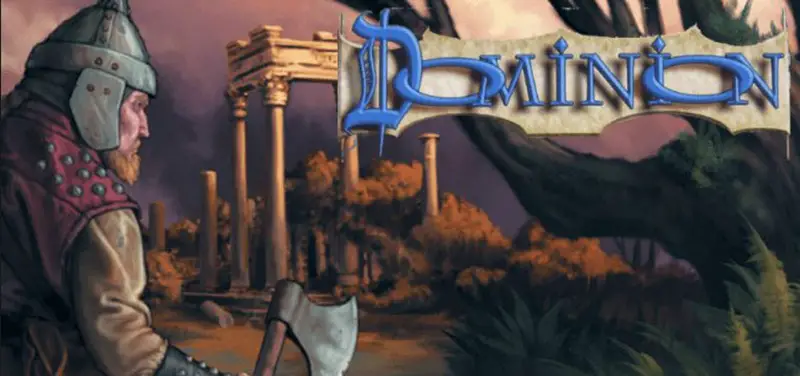
The Shelters
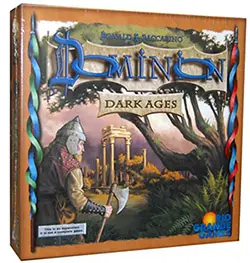
Dominion: Dark Ages introduces a new card type called "shelter", found on the three cards Hovel, Necropolis, and Overgrown Estate. One of each optionally replaces the three Estates in a starting player's deck. From testing I believe this is a straight upgrade that should always be used.
The shelters are not worth victory points, but all three help your deck. Hovel can be trashed from hand when you buy a victory card, which not only triggers off Duchy and Province but also Great Hall, Nobles, and the other multi-type victory cards.
Necropolis adds two Actions, and action adders are usually the fastest utility card to disappear from the supply. Overgrown Estate gives +1 card when you trash it.
The Ruins
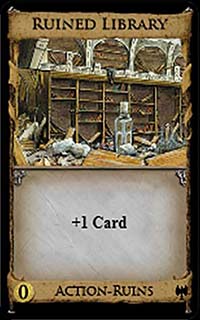
Dominion: Dark Ages also introduces a new card type called "ruins", all of which are actions.
Ruins cards are terrible. Abandoned Mine provides +$1 while using up your action for the turn. Ruined Village provides +1 Action while doing nothing other than perhaps boosting the Conspirator action count. You get the picture.
Players may buy ruins for $0, but typically would never want to do so. The ruins cards exist for two reasons: To be "offensive" cards that players can force into their opponents' decks using attacks, and to be "drawback" cards that players accept as a cost of gaining powerful supply cards.
For example Marauder is an action-attack that provides its player a treasure card from the set while forcing other players to gain a ruins. Death Cart is an action providing +$5 that costs only $4, but when you gain it, you must gain two ruins. Ruins factor prominently in the first preset game I am presenting today, "Cursecatchers".
The Knights
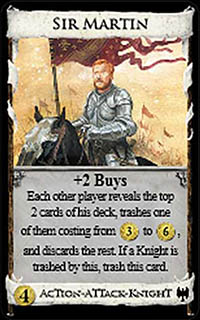
The final splashy new item in Dark Ages are the Knights, a supply pile of unique cards (thus turbocharging Cornucopia utility cards) that are powerful and versatile, but come at a cost.
None of the Knights figure into the preset games presented today, but we will definitely discuss them in the future.
Preset Game: "cursecatchers"
Everyone by now has played "the Curse game" with a grouping typically heavy on defense to provide some relief from the early rounds of Witches, Young Witches, and Sea Hags.
The problem with the Curse game is that quality trashing cards were few in Dominion overall, absent nuclear options like Chapel that offer no other functionality. That, and everybody scrambles for the Moats right away, pushing the variance level way up; too many of the supply piles are devoted to defense; and the attacks that inflict curses are rote and uninteresting.
Dark Ages improves "the Curse game" in three critical ways: providing better trashing utility than before, adding the new ruins cards to give the theme greater cohesion, and as a result of those two factors, opening up the endgame to more strategic decisions.
Core cards: Copper-Silver-Gold-Estate-Duchy-Province.
Starting cards: Hovel, Necropolis, Overgrown Estate
Supply piles: Ruins stack (Dark Ages), Spoils (Dark Ages), Bane card: Herbalist [2] (Alchemy); Ambassador [3] (Seaside), Death Cart [4] (Dark Ages), Junk Dealer [5] (Dark Ages), Marauder [4] (Dark Ages), Market Square [3] (Dark Ages), Saboteur [5] (Intrigue), Squire [2] (Dark Ages), Torturer [5] (Intrigue), Trader [4] (Hinterlands); Young Witch [4] (Cornucopia).
5th player add: Fortress [4] (Dark Ages). 6th player add: Jester [5] (Cornucopia).
The first thing you will need to know is that Death Cart is even better than it looks. Death-Cart-fueled Province buys are frighteningly common and the added utility of trashing its own Ruins penalty goes into overdrive when there are Curses and opposing Ruins to be trashed.
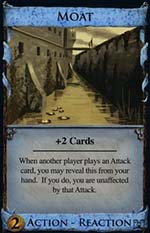
Of all the cards in Dark Ages that have a chance to become all-time Dominion tier-1 power like Moat, King's Court, and Peddler, Death Cart easily tops the list.
Like previous Curse-heavy games, "Cursecatchers" is heavy on attacks, with no less than five in the supply (and a sixth if you have a six-player game on).
And no Moat! But as you will see, the defense offered by Dark Ages' Market Square and the Hinterlands holdover Trader is excellent, with both of them meeting the Moat bimodal gold standard of being good whether you use them on another player's turn or your own.
Even innocuous cards like Junk Dealer will never leave a player upset to have drawn them. A sleeper is Dark Ages' two-cost Squire: early on it provides Silver or needed utility, and upon a good trashing opportunity it can directly be upgraded all the way to Torturer or Jester.
The late game becomes more interesting because of the interplay between Market Square and Saboteur, with Fortress in the mix in a game of at least five
Saboteur can rip Duchies and Provinces right out of a player's deck, and a player prepared with Market Squares will become flush with currency once this happens a few times.
It is up to the players to decide in a given turn whether to push late currency out for replacement Duchies and Provinces, or if it appears the player may not get another turn, to round out purchasing with however many estates the buys from their Market Squares (and Squires) will support.
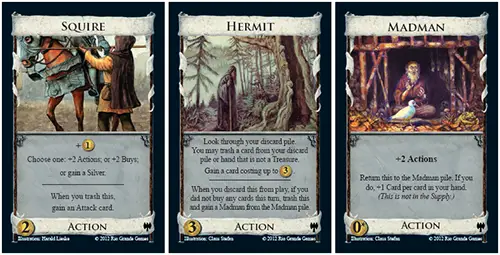
Preset Game: "the Copper Economy"
This is another existing preset game, and one of the more intriguing ones I've tried, so I was pleasantly surprised to see Dark Ages follow the lead of Hinterlands in providing multiple cards for the grouping.
Hinterlands made the preset playable, offering five of the ten supply cards. With Dark Ages, the game gains several more cards that are perfect fits for the grouping.
"The Copper Economy" turns a central play principle of Dominion on its ear: the worthlessness of Copper. It only takes a game or two before most players learn that Coppers are best trashed-and-upgraded or just trashed outright, despite their purchasing power in the early going. Not in this game! Copper is a powerful tool here.
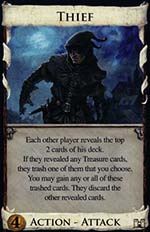
Most of the cards in the supply augment Copper, and developing "normally" with Silver and Gold is risky because of Noble Brigand and Thief. Only Beggar is available for defense, and the players developing the Copper strategy will want him more than those who aren't.
Core cards: Copper-Silver-Gold-Estate-Duchy-Province. Typically by rule, Platinum and Colony would be included because there is a card in the supply from Prosperity, Counting House. In practice, they won't affect the game, and I encourage house discretion in leaving them out.
Starting cards: Hovel, Necropolis, Overgrown Estate
Supply piles: Beggar [2] (Dark Ages), Cache [5] (Hinterlands), Coppersmith [4] (Masquerade), Count [5] (Dark Ages), Counting House [5] (Prosperity), Hamlet [2] (Cornucopia), Noble Brigand [4] (Hinterlands), Storeroom [3] (Dark Ages), Thief [4] (Dominion), Wandering Minstrel [4] (Dark Ages).
5th player add: Cutpurse [3] (Seaside). 6th player add: Inn [5] (Hinterlands).
The "money" combo in "The Copper Economy" is Coppersmith and Counting House. The action adders that make it playable, Hamlet, Inn, Necropolis, and Wandering Minstrel, augment the combo by helping you dump more Coppers to the discard pile.
If you find yourself missing the Counting Houses early, you can develop outside the Copper theme as long as you grab some Beggars, Storerooms, and Thieves to shift disruption away from you.
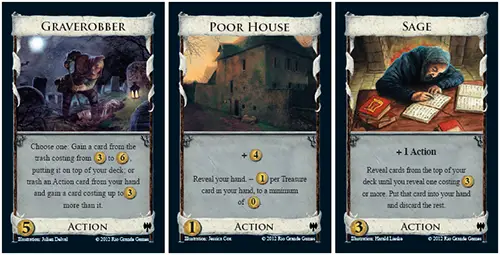
Preset game: "Victory Road"
This preset game is new as of Dark Ages, made possible by the Shelters and the accompanying cards that allow for trashing utility, as well as the various multi-type cards in Intrigue that provide utility on top of victory points.
Because the cost base skews high, there is only nominal disruption in this grouping, and the primary path to victory is based on purchase optimization.
Core cards: Copper-Silver-Gold-Platinum-Estate-Duchy-Province-Colony.
Starting cards: Hovel, Necropolis, Overgrown Estate
Supply piles: Crossroads [2] (Hinterlands), Feodum [4] (Dark Ages), Great Hall [3] (Intrigue), Harem [6] (Intrigue), Nobles [6] (Intrigue), Silk Road [4] (Hinterlands), Trade Route [3] (Prosperity), Treasury [5] (Seaside), Urchin/Mercenary [3] (Dark Ages), Vagrant [2] (Dark Ages).
5th player add: Tunnel [3] (Hinterlands). 6th player add: Farmland [6] (Hinterlands).
"Victory Road" presents a fundamental strategic choice to the player: Given a group of utility cards that benefit from the presence of victory cards, and given multi-type cards in the supply that are victory cards and double as somewhat expensive effects for their cost, is it better to focus on the multi-type cards and the versatility they offer, or to disregard them and use the utility cards to maximize a "vanilla" victory deck and its slightly higher per-card point value?

Crossroads is the house sauce if you choose the former, Treasury if you choose the latter, and Trade Route no matter what you do. This might be the single most beneficial supply pile grouping possible for Trade Route, absent shoving in even more multi-type victory cards at the cost of mono-type utility options.
A final note on Dominion: Dark Ages is that Rio Grande Games has once again avoided the trap of the Alchemy expansion, which provided cards that mostly cannot be played well in a grouping unless they are all played together, to the exclusion of other cards, thanks to the Potion cost mechanism.
Swinging the pendulum wildly the other way, Dark Ages' shelters, ruins, and Knights, to say nothing of the powerful Death Cart, Marauder, and Market Square, should quickly find themselves at home in combination with cards from throughout the Dominion expansions.
Continue Reading


